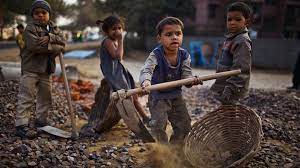Child Labor in Algeria

Child Labor is a prevalent issue throughout the world, but what can we do to stop it?
Throughout history, child labor has been an ongoing issue. From working in agriculture to being forced into factories, children have been taken advantage of to cut costs and provide low quality working conditions for businesses. Child Labor is defined as labor that harms the health of the child and deprives them of education rights. Children can be easily manipulated making them especially vulnerable to dangerous conditions. Socioeconomic disparities, along with a lack of access to education, contribute to the raising number of child labor victims. Children were and still are expected to work to contribute to family income, and have been forced to work in dangerous conditions for up to 12-hour shifts. The main cause of child labor is the lack of schools and poverty. According to the International Labor Organization, there are around 211 million child laborers, 73 million under 10 years old. 79 million children work under hazardous conditions. More than 8 million children are kept as slaves for domestic work, armed conflict, pornography, and prostitution. Globally, 22,000 children die annually because of work-related accidents. Almost one-third of the world’s child labor is in Africa. 56.4 percent of children aged 5-14 work in agriculture and 33.1 percent work in the industry, of those working. Although child labor is universally seen as unethical, many factors make up what goes into the need for child labor. Many families would not survive without the income gained from child labor. Many utilitarianism supports child labor as long as the labor is voluntary. Sometimes, the ends justify the means. Many children of a young age cannot fully consent to child labor because they can’t fully comprehend the complexity of the situation. Family poverty and ill-equipped schools are the two major reasons children in low-income countries are in the labor force. Around 1 in every 10 children is subjected to child labor. As of right now, there is no international agreement to enforce child labor fully. Children are robbed of their childhood, education, and the future that they deserve.
June 12th is the United Nations World Day Against Child Labor. UNICEF(United Nations Children’s Fund) was the first international committee that signed the Convention on the Rights of Children in 1989. The Minimum Age convention NO. 138 designates a minimum age for working children, which is described as the completion of compulsory school or not under 15 years old, that being said, if compulsory schooling is completed, then the minimum age is 14 years old. This bill also stipulates that dangerous jobs cannot employ those under 18 years old. This bill, however, fails to acknowledge children working in the informal economy, which is around 80% of all child labor. Resolution 71/177, adopted by the General Assembly on 19 December 2016, regards the Rights of the Child. This resolution not only reaffirms a previous resolution, 68/147, but also calls upon special attention paid to the rights of the child by representatives of the Secretary-General and Rapporteur of the Human Rights Council on the sale of children, child prostitution, and child pornography.
Although Algeria’s economy is growing, Algeria has been experiencing negative GDP growth since 2015. As of 2021, the GDP per capita for Algeria is $3,765 (USD) annually, according to World Data. Although only 4.5% of Algerians live below the poverty line, 28.60% of the population lives under $5.50 per day(USD). There is more than goes into child labor than just children working. Millions of families rely on child labor as a way to support their families. 40% of children aged 5-14 participate in child labor for survival in Sub-Saharan Africa, around 48 million children. The National Authority for the Protection and Promotion of Children launched in 2021 is an interagency program with the National Social, Economic, and Environmental Council to help governmental ministries to study children’s needs in Algeria, analyze child expenses, and develop a national action plan for child development. In Algeria, 3.6% of 5-15 year-olds are working, 94.8% are attending school, and 3.9% of 7-14 year-olds combine work and school. Algeria ratified International Conventions on Child Labor, including but not limited to, ILO C. 138, Minimum Age; ILO C. 182, Worst Forms of Child Labor; UN CRC Optional Protocol on the Sale of Children, Child Prostitution and Child Pornography; and more. In Algerian Legislation Article 303 bis 4 of the Penal Code meets the international standard of Prohibition of Forced Labor, as well as Articles 2, 319, 333 bis 1, 343, and 344 of the Penal Code, which also meets international standards of Prohibition of Commercial Sexual Exploitation of Children. Algeria also has multiple successful agencies responsible for Child Labor Law Enforcement, including the Ministry of Labor, Employment, and Social Security, which enforces labor laws related to child labor. The Government of Algeria has increased the number of working units dedicated to child labor. Algeria has also passed policies related to child labor, including a National Action Plan for the Prevention of and Fight Against Trafficking in Persons, which became active in 2021.
Due to the complexity of the crisis at hand, our best course of action is to solve the root of the problem, economic instability. To create a world where child labor is not needed to keep a family alive, we need to find a solution to strengthen the economy, in Sub-Saharan Africa, and throughout the world. What we can do is ask the International Monetary Fund to provide low-interest loans to Sub-Saharan countries to develop private businesses and public infrastructures, such as roads and schools. Lack of education makes children especially vulnerable to forced labor, so increasing access to the school will help form a better future for the child. Child labor is most prevalent in supply chains, like cacao, cotton, gold, and tea. An ILO organization, Accelerating Action for the Elimination of Child Labor in Supply Chains in Africa works with children in Africa.

Whenever there is a big new story, whether on campus or off, you’ll find Neve Walker at the heart of it. Neve is a senior at Cathedral, and in her second...




















































